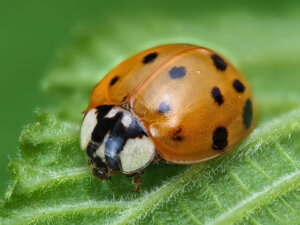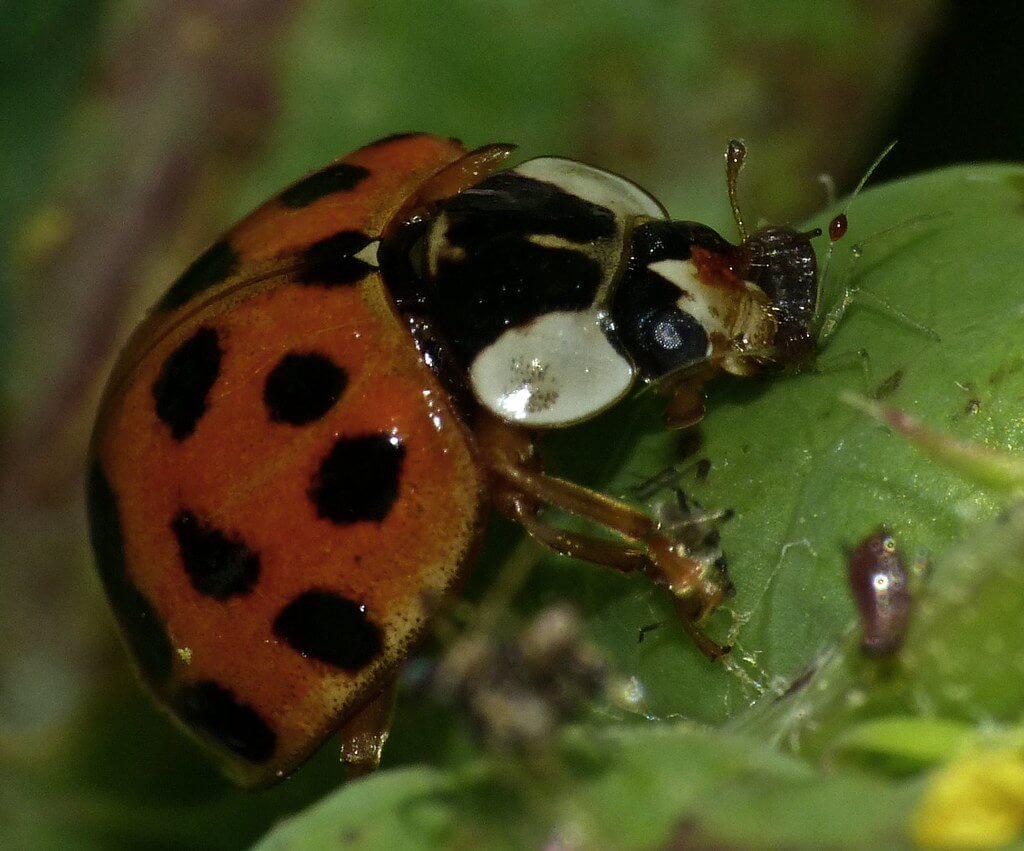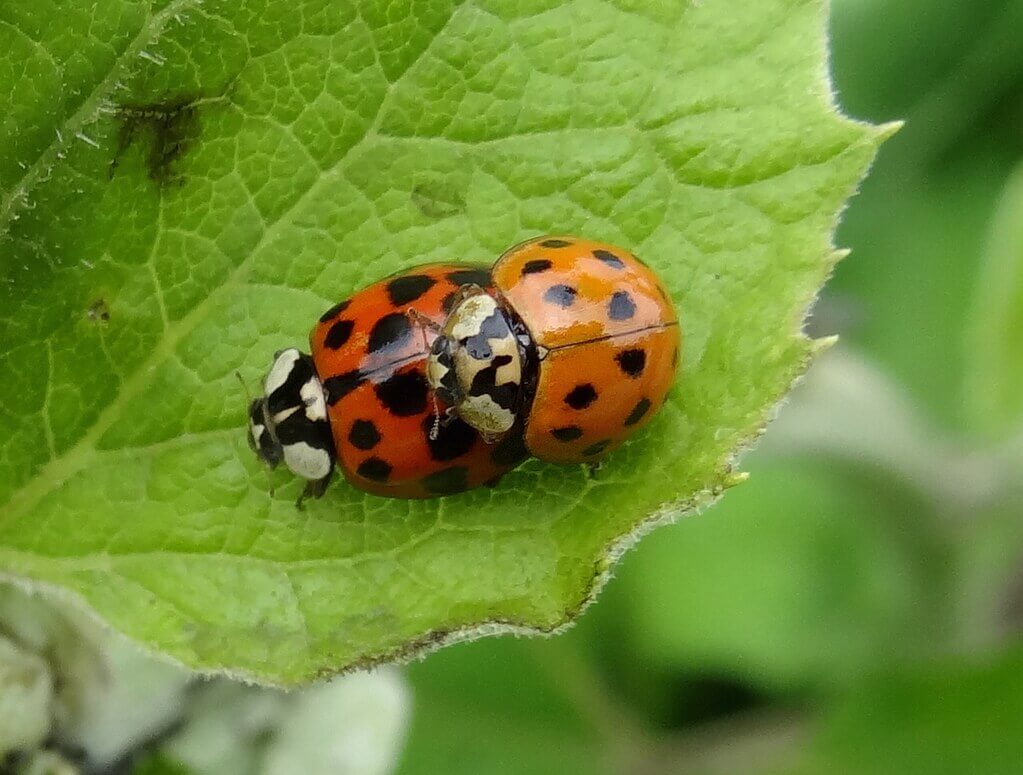Learn All About the Asian Lady Beetle


Written and verified by the biologist Cesar Paul Gonzalez Gonzalez
The Asian lady beetle is a small invertebrate characterized by a colorful, mottled body. Apart from having a pleasing appearance, it’s considered a good biological pest controller for plants. This is one of the reasons why its presence has spread around the world.
The scientific name of this species is Harmonia axyridis. It belongs to the family Coccinellidae, a group of coleopterans that are also called ladybugs. Read on to find out more about this peculiar little insect.
Habitat and distribution
As its name suggests, the Asian ladybug is native to eastern Asia. It can be found in China, Japan, Korea, Mongolia, Kazakhstan, and parts of Russia. However, it has been intentionally introduced to the rest of the world and can now be seen in the Americas, Europe, and Africa.
This species lives in areas with abundant vegetation, such as forests, grasslands, plains, and mountains. It’s also capable of adapting to different habitats as long as there are sufficient resources for its development. Thus, it can live in both urban and rural environments.

Physical characteristics of the Asian lady beetle
The Asian lady beetle goes through three phases or stages throughout its life. This means that their body changes (metamorphosis) as they grow, so they aren’t always found with the typical colorful appearance that they’re famous for. Each stage is described below:
- Larva: These have an elongated, segmented, worm-like body measuring between 2 and 10 millimeters in length. It exhibits a black coloration with some orange spots on the sides.
- Pupa: This stage is transitive and consists of the formation of a “dome” around the larva, which will protect its body while it undergoes metamorphosis to become an adult.
- Adult: They measure between 5 and 8 millimeters long. At this stage, its body is oval and its back has red or orange colors with black spots, while its head is white and has an “M” shaped spot. It also has two pairs of wings. The first ones are atrophied and hardened (elytra), but the second ones are functional and fold on its body to protect them.
The time it takes for an Asian lady beetle to pass from its larval stage to its adult phase is about 15 days. Although it sounds short, the life expectancy of a wild specimen is only 60 days, so the development process covers a large part of this.
Behavior
The Asian lady beetle is a solitary insect that moves around a lot in search of food. It’s most active during the day, since at night the temperature drops and this is detrimental to its metabolism. In fact, one of the few reasons why you may see several specimens together is because they get together to endure the cold of winter.
Asian lady beetle feeding
Like other ladybugs, this species is characterized by feeding on other small insects, such as aphids, mites, and mealybugs. However, it also occasionally consumes some fruit remains, pollen, and even its own eggs (cannibalism).
Most of the prey of this species are insects that infest plants and cause problems in crops. Therefore, it’s normal for the Asian lady beetle to be used as a biological controller in different countries. The only problem is that there’s a lack of adequate regulations for its introduction, so it is currently considered a risky invasive species.
Also, the presence of the Asian lady beetle in vineyards can be detrimental to their production, since they are capable of contaminating the wine when they accidentally fall into the liquid. As a result, the product has a more bitter taste and a different color that isn’t pleasant to the palate.
Reproduction
There’s no specific mating season for the Asian lady beetle. Once it reaches the adult stage, it breeds continuously until the end of its life. However, temperature does have some impact on this process. While heat promotes reproductive activities, cold slows them down.
To begin mating, females secrete pheromones that attract males and choose the one with the brightest coloration from among all of them. After selecting the mate, they proceed to copulate in an attempt to fertilize as many eggs as possible. At this point the role of the male ends, as he doesn’t exhibit parental care or protect the female.

The female may or may not mate with other males to ensure that all her eggs are fertilized (polygyny). She then lays about 25 fertilized eggs on the vegetation and adds some unfertilized eggs that will serve as food for her young. The first larvae will hatch about 3 days later and will have to fend for themselves, as they won’t have the help of their parents.
The Asian lady beetle is an interesting and peculiar insect that could easily go unnoticed, as there are several similar species around the world. However, this doesn’t detract from the fact that it’s fundamental to nature as it’s one of the most important biological controllers in its habitat. This is the reason why many entomologists, farmers, and the general population hold them in high esteem.
The Asian lady beetle is a small invertebrate characterized by a colorful, mottled body. Apart from having a pleasing appearance, it’s considered a good biological pest controller for plants. This is one of the reasons why its presence has spread around the world.
The scientific name of this species is Harmonia axyridis. It belongs to the family Coccinellidae, a group of coleopterans that are also called ladybugs. Read on to find out more about this peculiar little insect.
Habitat and distribution
As its name suggests, the Asian ladybug is native to eastern Asia. It can be found in China, Japan, Korea, Mongolia, Kazakhstan, and parts of Russia. However, it has been intentionally introduced to the rest of the world and can now be seen in the Americas, Europe, and Africa.
This species lives in areas with abundant vegetation, such as forests, grasslands, plains, and mountains. It’s also capable of adapting to different habitats as long as there are sufficient resources for its development. Thus, it can live in both urban and rural environments.

Physical characteristics of the Asian lady beetle
The Asian lady beetle goes through three phases or stages throughout its life. This means that their body changes (metamorphosis) as they grow, so they aren’t always found with the typical colorful appearance that they’re famous for. Each stage is described below:
- Larva: These have an elongated, segmented, worm-like body measuring between 2 and 10 millimeters in length. It exhibits a black coloration with some orange spots on the sides.
- Pupa: This stage is transitive and consists of the formation of a “dome” around the larva, which will protect its body while it undergoes metamorphosis to become an adult.
- Adult: They measure between 5 and 8 millimeters long. At this stage, its body is oval and its back has red or orange colors with black spots, while its head is white and has an “M” shaped spot. It also has two pairs of wings. The first ones are atrophied and hardened (elytra), but the second ones are functional and fold on its body to protect them.
The time it takes for an Asian lady beetle to pass from its larval stage to its adult phase is about 15 days. Although it sounds short, the life expectancy of a wild specimen is only 60 days, so the development process covers a large part of this.
Behavior
The Asian lady beetle is a solitary insect that moves around a lot in search of food. It’s most active during the day, since at night the temperature drops and this is detrimental to its metabolism. In fact, one of the few reasons why you may see several specimens together is because they get together to endure the cold of winter.
Asian lady beetle feeding
Like other ladybugs, this species is characterized by feeding on other small insects, such as aphids, mites, and mealybugs. However, it also occasionally consumes some fruit remains, pollen, and even its own eggs (cannibalism).
Most of the prey of this species are insects that infest plants and cause problems in crops. Therefore, it’s normal for the Asian lady beetle to be used as a biological controller in different countries. The only problem is that there’s a lack of adequate regulations for its introduction, so it is currently considered a risky invasive species.
Also, the presence of the Asian lady beetle in vineyards can be detrimental to their production, since they are capable of contaminating the wine when they accidentally fall into the liquid. As a result, the product has a more bitter taste and a different color that isn’t pleasant to the palate.
Reproduction
There’s no specific mating season for the Asian lady beetle. Once it reaches the adult stage, it breeds continuously until the end of its life. However, temperature does have some impact on this process. While heat promotes reproductive activities, cold slows them down.
To begin mating, females secrete pheromones that attract males and choose the one with the brightest coloration from among all of them. After selecting the mate, they proceed to copulate in an attempt to fertilize as many eggs as possible. At this point the role of the male ends, as he doesn’t exhibit parental care or protect the female.

The female may or may not mate with other males to ensure that all her eggs are fertilized (polygyny). She then lays about 25 fertilized eggs on the vegetation and adds some unfertilized eggs that will serve as food for her young. The first larvae will hatch about 3 days later and will have to fend for themselves, as they won’t have the help of their parents.
The Asian lady beetle is an interesting and peculiar insect that could easily go unnoticed, as there are several similar species around the world. However, this doesn’t detract from the fact that it’s fundamental to nature as it’s one of the most important biological controllers in its habitat. This is the reason why many entomologists, farmers, and the general population hold them in high esteem.
All cited sources were thoroughly reviewed by our team to ensure their quality, reliability, currency, and validity. The bibliography of this article was considered reliable and of academic or scientific accuracy.
- Sloggett, J. J., Magro, A., Verheggen, F. J., Hemptinne, J. L., Hutchison, W. D., & Riddick, E. W. (2011). The chemical ecology of Harmonia axyridis. BioControl, 56(4), 643-661.
- Saini, E. D. (2004). Presencia de Harmonia axyridis (Pallas)(Coleoptera: Coccinelidae) en la provincia de Buenos Aires. Aspectos biológicos y morfológicos. RIA. Revista de Investigaciones Agropecuarias, 33(1), 151-160.
- Grez, A. A., Zaviezo, T., Cervantes, G. G., & Rothmann, S. (2010). Harmonia axyridis in Chile: a new threat. Ciencia e investigación agraria: revista latinoamericana de ciencias de la agricultura, 37(3), 145-149.
- Pickering, G. J., & Botezatu, A. (2021). A Review of Ladybug Taint in Wine: Origins, Prevention, and Remediation. Molecules, 26(14), 4341.
- Koch, R. L. (2003). The multicolored Asian lady beetle, Harmonia axyridis: a review of its biology, uses in biological control, and non-target impacts. Journal of insect Science, 3(1).
- Graves, D. (2013). “Harmonia axyridis” (On-line), Animal Diversity Web. Recuperado el 23 de enero de 2023, disponible en: https://animaldiversity.org/accounts/Harmonia_axyridis/
This text is provided for informational purposes only and does not replace consultation with a professional. If in doubt, consult your specialist.








